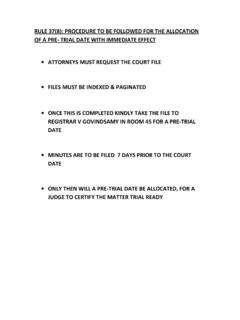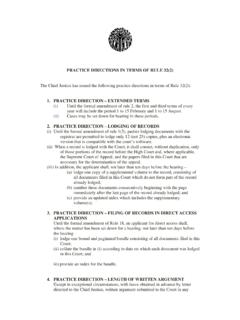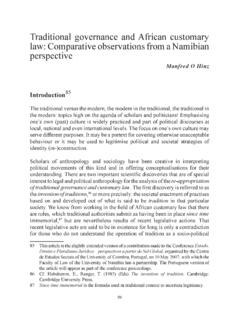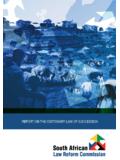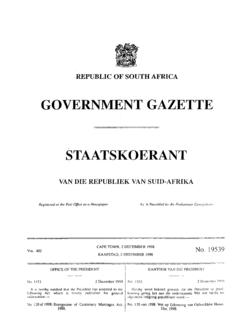Transcription of MT 32 - Recognition of Customary Marriages
1 JUSTICE COLLEGE Compiled by: MM Meyer: March 2009 Updated: MM Meyer: May 2012 Justice College, Private Bag X659, Pretoria, 0001 No part of this note may be reproduced or transmitted in any form or by any means without the required permission in writing. Masters Training Note No. MT 32 Recognition OF Customary Marriages 1 Recognition OF Customary Marriages TABLE OF CONTENTS 1. INTRODUCTION .. 3 2. THE LEGAL Recognition OF Customary Marriages .. 4 Which Marriages are recognised? .. 4 Customary Marriages entered into before 15 November 2000 .. 4 Customary Marriages entered into after 15 November 2000 .. 5 Subsequent civil Marriages .. 7 3. REGISTRATION OF Customary Marriages .. 7 Duty to register .. 7 Who may apply to register a marriage ? .. 11 Requirements to register a Customary marriage .. 12 4. STATUS AND CAPACITY OF SPOUSES.
2 13 5. PROPRIETARY CONSEQUENCES OF Customary Marriages .. 14 Introduction .. 14 Customary Marriages in existence before the commencement of the Act .. 14 Customary Marriages entered into after the commencement of the Act.. 16 Monogamous Customary Marriages .. 16 Polygamous Customary Marriages .. 16 6. DISSOLUTION OF Customary Marriages .. 18 7. THE RELATIONSHIP BETWEEN CIVIL AND Customary Marriages AND THEIR IMPACT ON ESTATES.. 18 Introduction .. 18 2 Effect of a civil marriage to a third person, on an existing Customary union: Situation before 2 December 1988 Areas outside the Transkei.. 19 Effect of a civil marriage to a third person, on an existing Customary union: Situation after 2 December 1988 until 15 November 2000 Areas outside the Transkei.. 20 Dual Marriages in Transkei.. 21 The position after 15 November 2000.
3 22 Recognition OF Customary Marriages ACT 120 OF 1998 .. 23 3 Recognition OF Customary Marriages 1. INTRODUCTION The Recognition of Customary Marriages Act, 120 of 1998, came into operation on 15 November 2000, and gives full legal Recognition to Customary Marriages for the first time in the history of South Africa. Prior to the commencement of the Act, Customary Marriages , (better known as Customary unions) did not enjoy the same status as civil Marriages concluded in terms of the marriage Act, 25 of 1961. Customary unions received partial Recognition for purposes of some legislation and common law, if they were registered under the Black Administration Act 38 of 1927. Partners in Customary unions were treated as spouses for the purpose of workmen s compensation,1 income tax,2 and Customary unions, as codified in the Black Administration Act, were also institutions in which women suffered unequal status and rights to men.
4 The Black Administration Act treated all women, regardless of age, capacity and marital status, as Women were not allowed to own property, sue or be sued in court, or exercise the power of contract. Women could not negotiate or terminate their Marriages , nor could they have legal custody of their children. The unequal status of Customary Marriages reflected the general approach of the pre-democratic governments to Customary law in South Africa. It was viewed as a system of law that was inferior to common law and legislation. Its acceptance 1 Compensation for Occupational Injuries and Diseases Act 130 of 1993, s 1. 2 The Income Tax Act 58 of 1962, s 1. 3 Maintenance Act 23 of 1962, s 1. 4 The Black Administration Act, 38 of 1927, s 11(3)(b). 4 as law was based on a concept of repugnancy defined by western, colonial and Christian values.
5 For example, Customary unions were not fully recognised because, potentially polygamous they were against good morals 5 2. THE LEGAL Recognition OF Customary Marriages Which Marriages are recognised? According to section 1 of the Act Customary marriage means a marriage concluded in accordance with Customary law, while Customary law means the customs and usages traditionally observed among the indigenous African peoples of South Africa and which form part of the culture of those peoples. In view of the fact that the definition of Customary law is limited to the customs and usages traditionally observed among the indigenous African peoples of South Africa, the Act does not apply to Customary Marriages concluded by African people outside of South Africa. From the above definitions it is also clear that Customary Marriages concluded in terms of Hindu and Muslim rites are not affected by the Act, and remain invalid unless they were solemnised in terms of the marriage Act, 25 of 1961 or the Civil Unions Act, 17 of 2006.
6 Customary Marriages entered into before 15 November 2000 Section 2(1) of the Act recognises Customary Marriages entered into before the commencement of the Act (15 November 2000), provided that such Marriages 5 Justice College, Customary Marriages Bench Book, February 2004, par. 5 were validly concluded in terms of Customary law and existed at the commencement of the Act. According to section 2(3) if a person was a spouse in more than one validly concluded Customary marriage as at date of the commencement of the Act, all the Marriages are recognised as Polygamous Marriages are thus given legal Recognition . Customary Marriages entered into after 15 November 2000 Section 2(2) recognises Customary Marriages entered into after the commencement of the Act (15 November 2000), provided the marriage complies with the requirements of the Act.
7 This also includes polygamous Marriages entered in terms of the Act [s 2(4)]. The general requirements for a valid Customary marriage entered into after the commencement of the Act are as follows:7 a) The prospective spouses must both be above the age of 18 years; b) They must both consent to be married to each other under Customary law; and c) The marriage must be negotiated and entered into or celebrated in accordance with Customary d) If either of the prospective spouses is a minor, both his or her parents, or if he or she has no parents, his or her legal guardian, must consent to the 6 Gama v Mchunu & Others, Case No 10/37362 dated in the South Gauteng High Court, Johannesburg. 7 Section 3 8 Fanti v Boto and Others 2008 (5) SA 405(C); Maluleke & others v Minister of Home Affairs & another [2008] JOL 21827 (W); Ndlovu v Mokoena & others [2009] JOL 23452 (GNP); Maloba v Dube & others [2010] JOL 25852 (GSJ) 6 marriage .
8 If there is no legal guardian, the Act provides for substitute e) The parties must not be prohibited from marriage because of relationship by blood or affinity as determined by Customary law. f) In addition to the above requirements, a husband in a Customary marriage who wishes to enter into a further Customary marriage with another woman after the commencement of the Act, must comply with a further requirement set out in section 7(6) of the Act, namely an application to the Court to approve a written contract which will regulate the future matrimonial property system of his Marriages . Failure to comply with the provisions of 7(6) of the Act will render the purported further Customary marriage The requirement that the marriage must be negotiated and entered into or celebrated in accordance with Customary law, as mentioned in (c) above, deserves special attention.
9 It should be noted that this requirement means more than merely an agreement to pay lobolo. In Fanti v Boto and Others11 it was held that the requirements for a valid Customary marriage are: (i) a consensual agreement between two family groups with respect to the two individuals who are to be married and the lobolo to be paid; and (ii) the transfer of the bride by her family group to the family of the The payment of lobolo is only one of the essential requirements and even if the payment of lobolo is properly alleged and proved, that alone would not render a relationship a valid Customary marriage in the absence of the other essential requirements. 9 Refer to sections 3(b), 4(a) & 4(c). 10 Legal opinion dated , given by the Chief State law Adviser to the Dept. of Home Affairs, under reference , and the decision of Mayelane v Ngwenyama and Anotherr [2010] JOL 25422 (GNP) 11 2008 (5) SA 405 (C).
10 12 The requirement that the woman must be formally transferred or handed over to her husband or his family was also confirmed in Sithole v Majeke & another [2011] JOL 27944 (GSJ). 7 The requirement of transfer of the bride by her family group to the family of the man is usually accompanied by well-known extensive rituals and ceremonies involving both families. The importance of these rituals and ceremonies is that they indicate in a visible way that a Customary marriage is being contracted and that lobolo has been paid and/or that arrangements which are acceptable to both families regarding the payment of lobolo have been made. Where these rituals and ceremonies have not taken place, or if such celebrations took place and were not in conformity with the specific customs of the families concerned, then such celebrations amounted to nothing but a party devoid of Customary Recognition .






